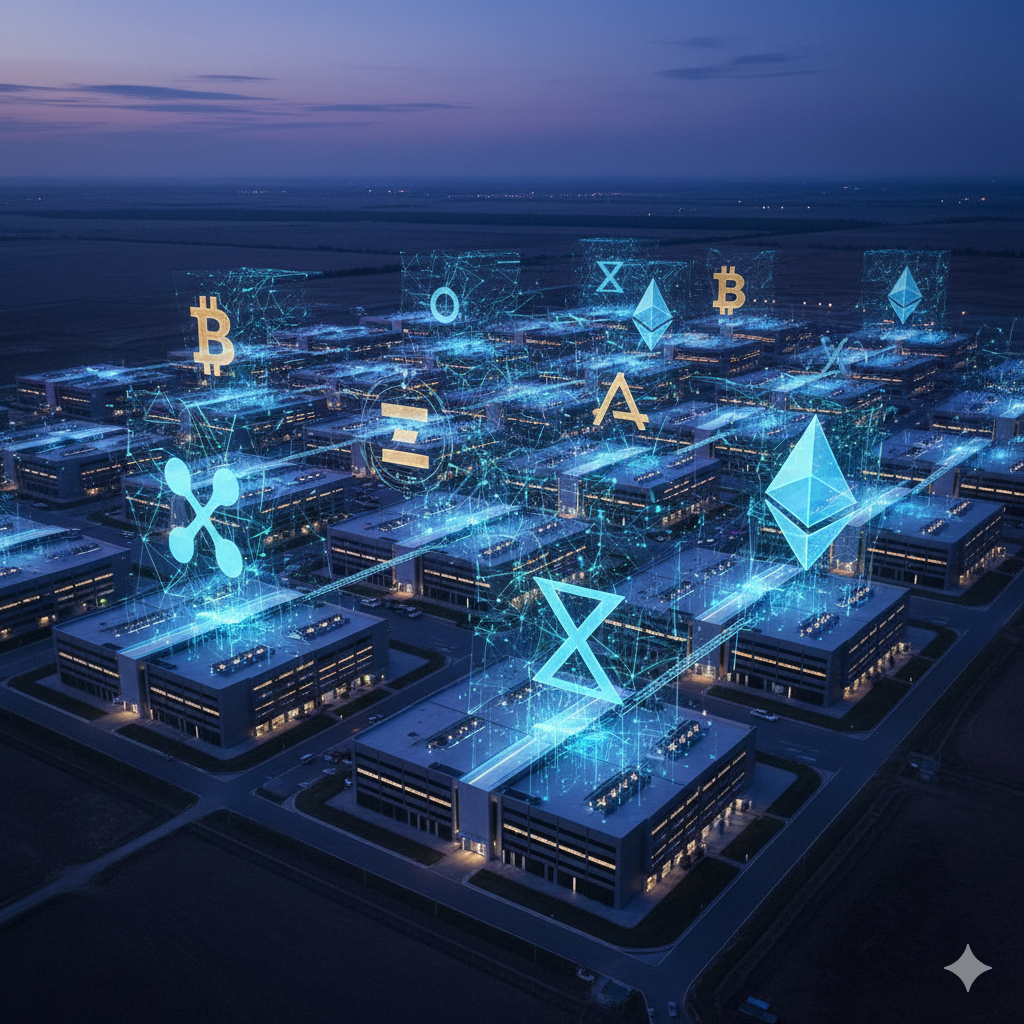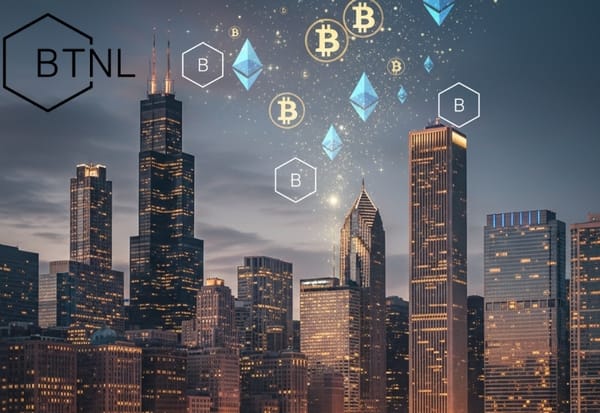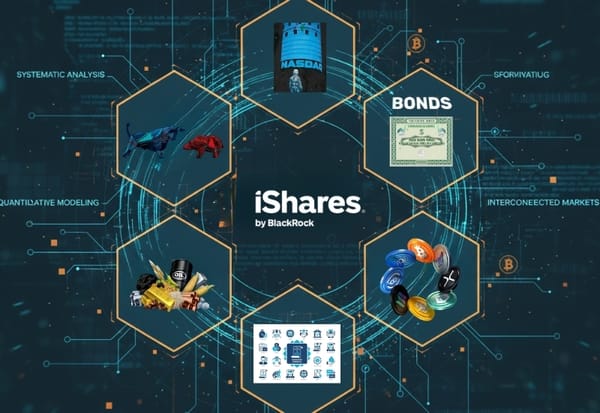BlackRock, Nvidia, Microsoft Lead Historic $40B Data Center Deal: What It Means for Crypto
BlackRock, Nvidia & Microsoft seal the largest data center deal in history—$40B for Aligned Data Centers. This AI infrastructure boom signals major implications for crypto payments & XRP adoption.

BlackRock, Nvidia, and Microsoft have sealed the largest data center acquisition in history—a $40 billion deal that signals a seismic shift in AI infrastructure and could reshape the digital asset landscape.
An investment consortium led by BlackRock, Nvidia, Microsoft, and Elon Musk's xAI announced Wednesday they will acquire Aligned Data Centers in a transaction valued at $40 billion. The deal, facilitated through the Artificial Intelligence Infrastructure Partnership (AIP), represents the largest data center acquisition on record and marks a pivotal moment in the race to build AI-ready infrastructure.
The Details: Who, What, and How Much
The acquisition brings together an unprecedented coalition of tech and finance heavyweights. The purchasing consortium includes the AIP partnership—comprising BlackRock, MGX (Abu Dhabi's AI investment arm), Microsoft, and Nvidia—alongside BlackRock's Global Infrastructure Partners and other strategic investors including the Kuwait Investment Authority and Singapore's Temasek.
Dallas-based Aligned Data Centers operates 50 campuses across the United States and Latin America with more than five gigawatts of operational and planned capacity. The company, currently owned by Macquarie Asset Management, designs and operates facilities for hyperscalers, neocloud providers, and enterprise clients.
AIP has an initial target of deploying $30 billion in equity capital, with potential to reach $100 billion including debt financing. This marks the partnership's first major investment since its formation in September 2024.
"With this investment in Aligned Data Centers, we further our goal of delivering the infrastructure necessary to power the future of AI, while offering our clients attractive opportunities to participate in its growth," said BlackRock CEO Larry Fink, who also serves as chairman of AIP.
The transaction is expected to close in the first half of 2026, with Aligned remaining headquartered in Dallas under CEO Andrew Schaap.
The AI Infrastructure Arms Race
This acquisition underscores an intensifying competition to secure the computing infrastructure needed to power artificial intelligence development. The deal follows recent mega-agreements from OpenAI totaling about 26 gigawatts of computing capacity—enough to power roughly 20 million U.S. homes.
Major tech companies including Alphabet, Amazon, Meta, Microsoft, and CoreWeave are on track to spend $400 billion on AI infrastructure this year, according to Morgan Stanley estimates. The scale of investment reflects the critical bottleneck that computing capacity has become for AI advancement.
The $40 billion deal values data center capacity at roughly $8 million per megawatt, signaling premium valuations for strategic infrastructure assets. BlackRock's Fink has repeatedly emphasized that "infrastructure is just at the beginning of a golden age" and that "the capex needed for AI infrastructure is only going to grow."
Market Implications: Beyond Traditional Tech
The deal's market impact was immediate. BlackRock shares rose nearly 2% in pre-market trading Wednesday, while Nvidia gained around 3%. But the implications extend far beyond these immediate movers.
The convergence of institutional capital, cutting-edge AI technology, and mission-critical infrastructure creates ripple effects across multiple sectors. Joe Tigay, portfolio manager at Equity Armor Investments, noted that the acquisition highlights the growing value of data center assets for investors.
This infrastructure buildout has profound implications for the crypto and blockchain ecosystem. As Larry Fink discussed at the World Economic Forum, the intersection of AI, blockchain, and digital infrastructure creates opportunities for tokenization, decentralized computing networks, and crypto-based payment rails.
The Crypto Connection: Infrastructure Meets Digital Assets
While this deal centers on AI infrastructure, its implications for cryptocurrency and blockchain technology are significant and multifaceted.
Payments Infrastructure and Tokenization
BlackRock's increasing embrace of digital assets positions this infrastructure investment as more than just traditional data center expansion. Fink recently stated that he sees the digital asset market—currently worth over $4.5 trillion—growing "significantly" over the next few years. BlackRock manages the largest Bitcoin and Ethereum ETFs in the U.S. with $93 billion and $17 billion in assets under management respectively, and operates the $2.8 billion BUIDL tokenized money market fund.
According to Chainalysis CEO Jonathan Levin, the adoption of stablecoins represents one of the most significant shifts in blockchain usage, with hundreds of billions of dollars now moving across blockchains while being stored in traditional financial institutions. This infrastructure enables the "rails" upon which these digital assets operate.
AI-Crypto Convergence
The convergence of AI and blockchain technologies is accelerating. A recent survey by Reown and YouGov found that 37% of participants cited artificial intelligence and payments as the key drivers for crypto adoption in 2025.
AI agents can integrate on-chain by leveraging crypto infrastructure rails for payments and digital resources, bypassing traditional banking complexities and offering permissionless, faster, and cheaper transactions. As data centers scale to support AI workloads, they simultaneously enhance the infrastructure supporting blockchain networks.
Decentralized Computing Networks
The data center boom also validates the thesis behind decentralized compute networks in crypto. Platforms like Render Network and Akash Network are tapping into underutilized global resources for GPU services, supporting decentralized machine learning and advanced applications. As centralized infrastructure becomes more expensive and capacity-constrained, decentralized alternatives gain competitive advantages.
XRP/Ripple Analysis: Strategic Positioning in the New Infrastructure Era
For XRP and Ripple, this infrastructure expansion presents both opportunities and strategic considerations.
Payments Infrastructure Advantage
Crypto payments saw significant year-over-year growth, with 34% of survey participants reporting active engagement, outpacing traditional DeFi use cases like farming and staking. Ripple's core focus on cross-border payments positions it to benefit from the broader digitization of financial infrastructure.
With new OCC and SEC guidance, banks are increasingly viewing blockchains as public infrastructure they need to rely on. Ripple's established relationships with financial institutions give it a first-mover advantage as traditional finance embraces blockchain rails.
AI Integration and the XRP Ledger
Ripple has been actively working to integrate AI capabilities into the XRP Ledger. Through Ripple's University Blockchain Research Initiative (UBRI), researchers are developing a programmable multi-agent execution layer that integrates with XRPL's transaction and settlement rails, allowing task-specific AI agents to operate on shared, auditable infrastructure.
The integration could enable smarter fraud detection, enhanced analysis, and new forms of on-chain intelligence. As AI infrastructure scales globally, XRP's low-latency, low-cost transaction capabilities become increasingly valuable for AI-driven payment systems.
Price Implications and Technical Setup
XRP technical analysts are highlighting what they describe as an "explosive" setup, with the cryptocurrency maintaining solid ground above the $1.94 level and testing resistance at $3.25. The bullish projection extends toward $6.28, which would represent roughly a 150% gain from current levels.
Several fundamental factors support this technical outlook:
- Institutional Growth: CME Group data shows that XRP futures have crossed the $1 billion open interest mark just three months after launch, signaling growing institutional demand.
- Infrastructure Timing: The convergence of AI infrastructure investment and blockchain adoption creates a favorable macro environment for payment-focused cryptocurrencies.
- Regulatory Clarity: The EU's MiCA regulation and U.S. SEC guidance have created clearer compliance pathways, reducing legal uncertainty for enterprises, which could accelerate Ripple's institutional partnerships.
Competitive Positioning
While XRP doesn't directly compete with data center operators, the broader trend toward institutional infrastructure investment validates Ripple's long-term strategy. Ripple provides stablecoin-powered cross-border payments and digital asset custody solutions, positioning itself as infrastructure for the financial system.
As BlackRock and institutional investors pour capital into physical AI infrastructure, parallel investments in blockchain financial infrastructure become more attractive. Ripple's focus on compliant, enterprise-grade solutions aligns with this institutional migration.
Partnership Opportunities
The involvement of major players like Microsoft, which has partnered with Ripple in various capacities, suggests potential synergies. As these companies build AI infrastructure, the need for efficient, low-cost payment rails for AI agents and automated systems could drive adoption of XRP Ledger-based solutions.
Key Takeaways
The BlackRock-led consortium's $40 billion acquisition of Aligned Data Centers marks more than just another big tech deal—it signals a fundamental restructuring of digital infrastructure. For crypto investors and XRP holders, several key insights emerge:
- Infrastructure validation: Institutional capital is flowing into digital infrastructure at unprecedented scale, validating the thesis that computing power and data processing are critical 21st-century assets.
- Convergence accelerating: The lines between AI infrastructure, blockchain networks, and traditional finance are blurring rapidly. Companies positioned at these intersections—like Ripple—stand to benefit.
- Payments focus: Payment applications are becoming the dominant real-world crypto use case, with 27% of participants pointing to payments as the on-chain experience that will become dominant in the next three to five years.
- Institutional embrace: BlackRock's simultaneous push into both AI infrastructure and digital assets (Bitcoin ETFs, tokenization, stablecoins) suggests these sectors are viewed as complementary rather than competing investments.
- Scale requirements: The $100 billion potential scale of AIP's investments demonstrates that next-generation infrastructure requires unprecedented capital deployment—a trend that benefits established, well-funded projects over speculative newcomers.
For XRP specifically, the infrastructure boom creates a favorable backdrop for institutional adoption while Ripple's AI integration efforts position it to capitalize on the convergence of these technologies. However, investors should monitor regulatory developments, partnership announcements, and actual adoption metrics rather than relying solely on technical price targets.
The message is clear: infrastructure is the new frontier, and whether it's data centers for AI or blockchain rails for payments, institutional money is betting big on the digital future.
Sources
- CNBC - Nvidia, Microsoft, BlackRock aligned data centers
- Reuters via WTVB - BlackRock, Nvidia-backed AI consortium
- CP24 - BlackRock, Nvidia-backed AI consortium to buy Aligned Data Centers
- Dallas News - BlackRock, Nvidia-backed group to buy D-FW data center company
- Yahoo Finance - BlackRock, Nvidia to buy Aligned Data Centers
- The Block - BlackRock and Nvidia's $40 billion data-center deal
- Bitcoinist - Ripple Is Giving The XRP Ledger An AI Brain
- TheTradable - XRP News Prediction: Explosive Setup Ahead
- PYMNTS - From Fringe to Financial Infrastructure: How Blockchain Became Bankable
- Cointelegraph - Crypto adoption in 2025 spurred by payments, AI
- BlockApex - Crypto and AI: How the two industries will emerge in 2025
- AInvest - 2025 Crypto Infrastructure Innovation
- CoinDesk - BlackRock CEO Larry Fink eyes bigger role in tokenization
- CNBC - BlackRock Chairman & CEO Larry Fink interview
- Ripple Official Website
DISCLAIMER: This newsletter is for informational purposes only and does not constitute investment advice, advertising, or a recommendation to buy, sell, or hold any securities. This content is not sponsored by or affiliated with any of the mentioned entities. Investments in cryptocurrencies or other financial assets carry significant risks, including the potential for total loss, extreme volatility, and regulatory uncertainty. Past performance is not indicative of future results. Always consult a qualified financial professional and conduct thorough research before making any investment decisions.



